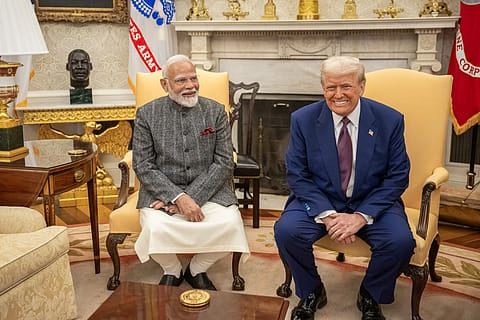As Trump's August 1 deadline looms, India pins hopes on the main trade deal
Instead of a quick fix, Indian and US negotiators seem to be sticking to their original mandate - to negotiate the first tranche of a mutually beneficial, multi-sector Bilateral Trade Agreement (BTA) by September–October 2025.

Even as the 1 August deadline, announced by US President Donald Trump to enforce the tariff threats made by him against his country’s trading partners including India, draws closer, a quick, mini India-US trade deal to help India avert high tariffs on goods exports to the US remains elusive.
Instead of a quick fix, Indian and US negotiators seem to be sticking to their original mandate - to negotiate the first tranche of a mutually beneficial, multi-sector Bilateral Trade Agreement (BTA) by September–October 2025. Irrespective of whether Trump announces higher tariffs on Indian goods or not, the next round of BTA negotiations will take place in India when US officials visit New Delhi in the second week of August.
Trump had announced a reciprocal tariff of 26% on all products exported from India, though he delayed its implementation until 1 August. A mini deal would have seen some reduction in the effective tariff, as has happened in the case of several countries including Indonesia, the Philippines, and Japan, after those countries agreed to offer tariff concessions for US goods.
In the absence of such a quick deal, India faces the threat of a unilateral tariff hike announcement by Trump on 1 August. It could make the BTA negotiations tougher, as it would mean an erosion of the current strengths and competitiveness India is perceived to have in relation to its competitors in the US market.
For instance, a recent analysis by government think tank NITI Aayog indicated that US tariffs on competitors are higher than India’s in 22 out of the top 30 products India exports to the US. In six of the top 30 categories, India faces slightly higher average tariffs — up to 3% — than other leading exporters, with the majority of them having marginally higher tariffs between 0–2%, NITI Aayog noted. The observations made in the latest Quarterly Trade Watch report said these specific product categories account for over 12% of total US imports, underscoring the scale of opportunity available for Indian exporters. It also said these differences are modest and present a strategic opportunity for India to engage in targeted negotiations with the US. Any unilateral tariff will weaken this perceived advantage.
The best way to illustrate this is to look at the tariff differential India has vis-à-vis China in the US market. NITI Aayog says the average tariff differential between Indian and Chinese exports is 20.5% in India’s favour. A 20% tariff hike on Indian exports could therefore reduce the possibility of leveraging the tariff differential and gaining market share.
In fact, NITI Aayog’s study says that tariff data at the HS-4 level across the top 100 products reveals that in 80 products, competitors face higher tariffs than India in the US. Out of these, 78 products — representing 52% of India’s total exports to the US and accounting for a 26% share in total US imports — are expected to see improved competitiveness for India. Of these 78 products, China is the top exporter to the US in 34 products, and hence the importance of the tariff differential.
Recommended Stories
If India and the US fail to agree on a quick, mini deal, it is not because India is not keen on such a deal, but because of the inherent complexities and country-specific sensibilities that need to be considered. Sankhanath Bandyopadhyay, Economist at Infomerics Valuation and Ratings, says that the delay in finalising a US-India trade deal underscores the complexity of balancing economic pragmatism with domestic sensitivities. “For India, agriculture and dairy aren’t just trade sectors; they are the backbone of rural livelihoods, impacting over 700 million people. Meanwhile, the US is pushing hard for access to India’s high-tariff markets, especially in agri and digital sectors, while raising tariffs on Indian steel, aluminium, and auto exports. This asymmetry has stalled progress,” Bandyopadhyay says. “Unlike recent US trade partners like the UK or Vietnam, India is not willing to concede on politically critical sectors and is instead negotiating from a position of strategic autonomy. But prolonged delays carry risks: lost export competitiveness, retaliatory tariffs, and a dent in the broader US-India strategic alignment, including tech and defence cooperation,” he said.
As of now, Indian negotiators are confident of keeping the mutually agreed timeline for the India-US BTA. If the main deal is on track, missing unilaterally set deadlines could only be a temporary setback.